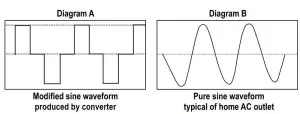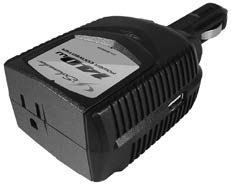Schumacher Power Converter XI14 Owner’s Manual
MODEL: XI14
PLEASE SAVE THIS OWNERS MANUAL AND READ BEFORE EACH USE.This manual will explain how to use the converter safely and effectively. Please read and follow these instructions and precautions carefully.
1. IMPORTANT SAFETY INSTRUCTIONS
SAVE THESE INSTRUCTIONS.
- SAVE THESE INSTRUCTIONS. This manual will show you how to use your convertersafely and effectively. Please read, understand and follow these instructions and precautions carefully, as this manual contains important safety and operating instructions.WARNING: The converter output is 120V AC and can shock or electrocute the same as any ordinary household AC wall outlet.
- Do not cover or obstruct the converter’s vents.
- Use the converter in a well-ventilated area.
- This converter is not intended for use by children.
- Do not expose the converter to rain or snow.
- Ensure that the converter is located away from normal traffic areas.
- Use only accessories recommended or sold by the manufacturer.
- Do not operate the converter with damaged or undersized wiring.
- Do not operate the converter if it has received a sharp blow, been dropped or otherwise damaged in any way; take it to a qualified service person.
- Do not disassemble the converter; take it to a qualified service person when service or repair is required. Incorrect reassembly may result in a risk of fire or electric shock.
- Make sure the converter is not close to any potential source of flammable fumes, gases or clothing.
- Do not place the converter in areas such as battery compartments or engine compartments where fumes or gases may accumulate.
- Disconnect both AC and DC power from the converter before attempting any cleaning.
- DO NOT operate the converter if you, the converter, the device being operated or anyother surfaces that may come into contact with any power source are wet. Water andmany other liquids can conduct electricity, which may lead to serious injury or death.
- Do not place the converter in direct sunlight. The ideal air temperature for operation is between 50° and 80°F.
- Only connect the power converter to a 12V accessory outlet or 12V battery.
- Do not attempt to connect the converter to any other power source, including an AC power source. Connecting to a 6V or 16V battery will cause damage to the converter.
- Do not modify the AC or USB receptacle in any way.
- Do not try extending or otherwise changing the 12V power cord attached to your converter.
- Incorrect operation of your converter may result in damage and personal injury.
- This device does not include an internal Ground Fault Circuit Interrupter (GFCI). For GFCI protection, use a Coleman Cable 02822 GFCI outlet.
- Restrictions on Use: This converter may not be used in life support devices or systems. Failure of this converter can reasonably be expected to cause failure of that life supportdevice or system, or to affect the safety or effectiveness of that device or system.
2. FEATURES
3. BEFORE USING YOUR CONVERTER
- Automotive batteries are recommended for only a short period of time of an hour or less.
- Do not use the converter with a product that draws a higher wattage than the converter can provide, as this may cause damage to the converter and product.
When you turn on a device or a tool that runs on a motor the device goes through 2 stages:
- Start Up – Requiring an initial surge of power (commonly known as the “starting” or “peak” load).
- Continuous Operation – Power consumption drops (commonly known as the “continuous load”).
- The wattage (WATTS) or amperes (AMPS) can normally be found stamped or printed on most devices and equipment, or in the user’s manual. Otherwise, contact the manufacturer to find out whether the device you want to use is compatible with a modified sine wave.
- To calculate the wattage: Wattage = AMPS x 120 (AC Voltage).
- To calculate the starting load: Starting Load = 2 x wattage.
- In general, the startup load of the device or power tool determines whether your converter has the capability to power it.
- Always run a test to establish whether the converter will operate a particular piece ofequipment or device. In the event of a power overload, the converter is designed to automatically shut down.
- This safety feature prevents damaging the converter while testing devices and equipment within the wattage range of the converter.
- When using the vehicle’s 12 volt accessory port, this converter is designed to supply 60 to 70 watts when the vehicle is not running. With the vehicle’s engine running, it can supply up to 100 watts. To use the full output, you must connect the converter directly to your battery.
NOTE: The 100 watt limit is to accommodate the fuse ratings for all vehicles. Some vehicles may allow the full output. If the fuse blows when you switch on the device you are trying to use, you have to either use a smaller device or you must connect the converter directly to the battery.
IMPORTANT: This converter uses a modified sine waveform (diagram A) which is not quite the same as power company electricity (diagram B). For the following devices, we strongly recommend that you use caution and check the device’s manual to make sure it is compatible with modified sine waveform.
- Switch mode power supplies
- Linear power supplies
- Class 2 transformers
- Line filter capacitors
- Shaded pole motors
- Fan motors
- Microwave ovens
- Fluorescent and high intensity lamps (with a ballast)
- Transformer less battery chargers
Using the converter with any of these devices may cause the device to run warmer or overheat.

IMPORTANT: If you are using the power converter to operate a battery charger, monitor the temperature of the battery charger for about 10 minutes. If the battery charger becomes abnormally warm, disconnect it from the converter immediately.
NOTE: You may hear a “buzzing” sound being emitted from inexpensive sound systems when operated with the converter. This is due to ineffective filters in the sound system’s power supply. Unfortunately, this problem can only be resolved by purchasing a sound system with a higher quality power supply or higher quality filter.
4. OPERATING INSTRUCTIONS
CONNECTING THE CONVERTERIMPORTANT: Make sure you connect your converter to a 12V power supply only.
- Remove the cigarette lighter from its outlet.
- Push the 12 volt power plug firmly into the outlet.ATTENTION: Failure to make the correct connections will result in blown fuses andpermanent damage to the converter.
- The LED indicator light should glow GREEN, verifying the converter is receiving power.NOTE: You may hear a “buzzing” sound being emitted from the cooling fan.
- Make sure the device to be operated is turned OFF.
- Plug the device into the converter’s AC outlet or USB port.
- Turn the device on.
- To disconnect, reverse the above procedure.
NOTE: If more than one device is to be powered, start one device at a time to avoid a power surge and overloading the converter. The surge load of each device should not exceed the converter’s Continuous Operation wattage rate.
5. POWER SOURCE
Your average automobile or marine battery at full charge will provide an ample power supply to the converter for approximately 3 hours when the engine is off. The actual length of time the converter will function depends on the age and condition of the battery and the power demand being placed by the device being operated with the converter.
If you decide to use the converter while the engine is off, we recommend you turn OFF the device plugged into the converter and disconnect the converter’s plug from the 12 volt accessory outlet before starting the engine. To maintain battery power, start the engine every 2 to 3 hours and let it run for approximately 10 minutes to recharge the battery.
Although it is not necessary to disconnect the converter when turning over the engine, it may briefly cease to operate as the battery voltage decreases. While the converter draws very low amperage when not in use, it should be unplugged, to avoid battery drain.
6. HOW POWER CONVERTERS WORK
There are two stages involved in converting 12 volt DC (battery) power into 120V AC (household voltage):
STAGE 1: The power converter uses a DC to DC transformer to increase the 12- volt DC input voltage from the power source to 145 volt DC.
STAGE 2: The converter then converts the 145 volt DC into 120 volts AC (household voltage) using advanced MOSFET transistors in a full bridge configuration. A “modified sine wave” waveform is generated by this conversion.
7. LED INDICATOR AND SHUTDOWN PROTECTION
The LED glows GREEN automatically when plugged into a 12 volt DC source andwill not glow under the following conditions:
- When the power input from the vehicle’s battery drops to approximately 10 volts, low battery shutdown occurs and the converter shuts of. Recharge or replace the battery.
- When the power input from the vehicle’s battery exceeds 15 volts, high voltage protection occurs. Reduce the voltage range to between 12 volts and 14 volts.
- The continuous load demand from the equipment or device being operated exceeds the continuous load rating of the converter. Use a higher capacity converter or lower rated device.
- The case temperature becomes hot (exceeds 145°F). Allow the converter to cool. Do not block the cooling slots or air flow over and through the converter. Reduce the load on the converter to the continuous rated output.
RESET: To reset after shutdown occurs, remove the 12 volt plug from the accessory outlet. Check the source of the problem and correct. Reinsert the 12 volt plug into the accessory outlet.
8. IF THE CONVERTER’S FUSE BLOWS
Your power converter is fitted with a fuse, which should not have to be replaced under normal operating conditions. A blown fuse is usually caused by reverse polarity or a short circuit within the device or equipment being operated.
If the fuse does blow:
- Disconnect the device or equipment immediately.
- Find the source of the problem and repair it.
- Install a new 15 amp fuse. The fuse can be found on the end of the plug on the converter.
- Do not over tighten the fuse cap; finger-tight is sufficient.
IMPORTANT: Do not install a fuse higher than 15 amp, as this may damage the converter. Make sure to correct the cause of the blown fuse before using the converter again.
9. TROUBLESHOOTING

10. SPECIFICATIONS
- Maximum continuous output………………………………………………………… 140 Watts
- Surge capability (0.1 second)………………………………………………………. 280 Watts
- No load current draw……………………………………………………………………….<0.25A
- Input voltage range……………………………………………………………. 10.5V-15.5V DC
- Output voltage range……………………………………………………………..120V±5% AC
- Low battery shutoff……………………………………………………………. 10.5V±0.3V DC
- Optimum efficiency……………………………………………………………………………..85%
11. REPLACEMENT PARTS
Fuses – Replacement fuses can be purchased at most electronic component retailers
12. BEFORE RETURNING FOR REPAIRS
For REPAIRS OR RETURNS, visit 365rma.comVisit batterychargers.com for Replacement Parts.
13. LIMITED WARRANTY
For information on our one year limited warranty, please visit batterychargers.com or call 1-800-621-5485 to request a copy. Go to batterychargers.com to register your product online.
References
[xyz-ips snippet=”download-snippet”]

